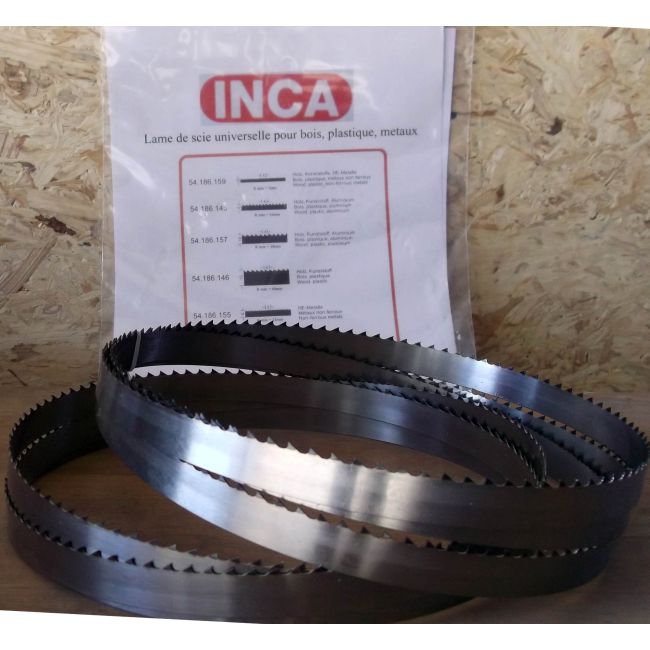60 inch bandsaw blades (1525mm) (Pack of 2)
Sears Craftsman, Atlas Excel, Wells 49, 300, 49A,Junior Dayton 3Z360, Shopmaster, Rigid 945,Emerson 10-1451, 10-1455,Greenlee 1357, Greenley, Grizzly GI 010. The blades mentioned on this page are 60 inch bandsaw blades (1525mm) in length. These are offered for sale in packs of two.
Require a different, custom length? We're able to custom make a band-saw blade to your requirements at no extra cost, please click here.
Why choose Inca? Click here to know more.
Inca Woodworking machines - our team have got a tradition with regard to creating top quality goods -- these bandsaw blades happen to definitely be no different. They are developed to last longer, we have tried a lot of band saw blades and our blades last five times longer compared to many of our competitors. That is several fewer times in which you are going to need to travel to the sharpener and dish out to get your own blade sharpened.
Precisely how can we have accomplished this consistent quality! This starts just by choosing premium materials, we exclusively work with the top EU steel (British as well as Swedish) and design our own blades within France through our specialist employees. After all, having over 75 years in the wood-working industry, we fully understand exactly how important a fine blade is. So why get the best bandsaw and after that order a poor blade? We have seen this occur-- you buy the top bandsaw in the market and then end up with a sub-par blade and usually the saw will get the blame! You want your equipment to deliver the results, effectively, without problems and routinely.
We all exclusively offers blades designed to cut wood, when you're searching for metal cutting blades regrettably Inca Machines isn't the company for you. The blade is readily available in 3 TPI, 4TPI, 6TPI and 14TPI. If that isn't the size you're looking for then simply just examine this made to order blade section, which is where we will get a blade to your individual criteria with entirely no extra expense!
It is essential to select the blade for you, selecting the perfect width, thickness and teeth for your band saw can make a signficant difference. First of all, take into account what you're going to use the blade for. There is 'one blade fits all' answer.
Blade Length:
The listed blades are 60 inches in length in other words 1524mm in the metric system. Refer to the handbook which comes together with your band saw to make sure you have picked the appropriate length. In cases where a 60 inch blade is too long or small you will either be unable to effectively stress the blade or the blade is not going to fit the bandsaw.
>Blade Thickness:
Any time it comes to blade thickness, if you are mainly re-sawing or cut-off sawing we would certainly suggest that you just opt for the maximum thickness feasible, so that you may have a very good feed level and a great straight cut with out breaking your blade. Thick blades can conveniently take straight cuts however have a lot more issues when twisting or bending.
That is certainly where a good thinner blade is helpful - You would need to use a thinner blade whenever you happen to be radius cutting. It is essential to find the right equilibrium, somewhere between thick and thin, woodworkersdo tend to use the thicker blades as they may be cutting a dense piece of wood, which at times may be the wrong approach. Failure to choose the ideal blade can result in the blade heating and cooling in the long run weakening the blade and inducing failure.
Teeth per inch:
Just as before, picking the right teeth per inch is essential and very much related to the task . Do you want to have the ability to slice through the wood rapidly : in that case the lowest TPI (Minimum 3TPI) can offer a rough finish an allow you to let you to you to cut speedily. Alternatively, when it's necessary to slice the wood with a smooth finish, a larger TPI with a slower cut is going to do the job!
Blade Upkeep
As a final point, bear in mind to look after your blade when using it! You're likely to get more years from your blade by ensuring that you're de-tensioning the blade after you have worked with it. Your blade will heat up whilst cutting, this results in the blade expanding and subsequently contracting which could cause metal failure much earlier than expected.

 French
French



